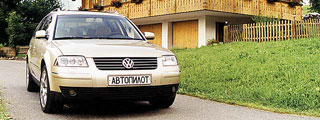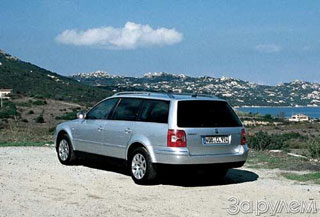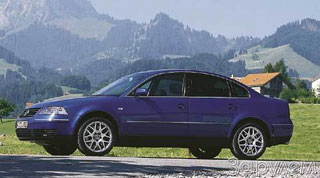Test drive Volkswagen Passat B5 2000 - 2005 sedan
Heartless from Wolfsburg
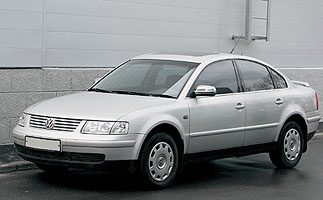 In the secondary market from the Passata-B5, they literally go crazy. As once, in 1997 they went crazy with the latest Passat-B5. Does the universal favorite deserve such recognition in the fourth and fifth year of life?
In the secondary market from the Passata-B5, they literally go crazy. As once, in 1997 they went crazy with the latest Passat-B5. Does the universal favorite deserve such recognition in the fourth and fifth year of life? Doomed to success
First of all, the Passat bribes a rare ability to give itself dearly. Not only does it come close to the business class with dimensions and sizes, it also looks very aristocratic. And the interior decoration? The Passato-B5 has been six years old, but still none of the competitors (prestigious brands like a Mercedes Benz, BMW and Audi do not count) have learned how to make such an expensive look and pleasant to the touch salon. Plus magnificent sled qualities, noise insulation and smoothness. The Passat is solid and roads in each of its details. It is actually perceived by the car by the class above. And the belief of many is that in its middle class it is the best is really difficult to dispute.
However, the design of the Passata-V5 was so advanced that the car came out with a whole bouquet of childhood diseases. In the first two years, the admirers of the Passat were divided into those who dreamed of buying this car, and those who thought of getting rid of it were often helped often helped. Passat’s theft in the early years was simply amazing. Part of the sores managed to get rid of the model year by 1998, and those that remained are probably already eliminated under warranty. Nevertheless, it is better to buy the Passat starting from the 99th model.
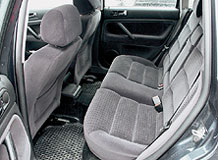
In its class, the Passat is phenomenally spacious behind
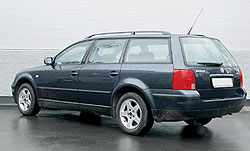 Great option
Great option The options for Volkswagen are traditionally called the wagon body. If you are looking for a middle-class station wagon, attention should be paid to the passato. In the first place. Its harmonious design is very successful with functionality. The luggage compartment of the option is planned very rationally, and the shape of the back of the body is designed so that the internal volume is used as efficiently as possible. In addition, the passato option is well resold. This is a really great option.
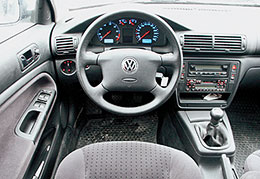 Is the body galvanized?
Is the body galvanized? Legends about galvanized Volkswagen bodies have been going on in Russia for ten years now. Those who wish to believe in this even came up with a fairy tale about the letters ZZZ in Vina. In fact, it was B5 that became the first Volkswagen with a fully galvanized body and a 12-year guarantee of through corrosion.
It seems that the statements of the Germans are not unfounded. Even among cars that survived five Moscow winters, the body looks worthy. With the exception of the exception of the paint striking from the stones on the edges of the front wheeled arches. However, there is one place where even the zinc coating does not save. About three years later, overwhelming paint appears above the upper edge of the windshield. Apparently, the body aerodynamics are such that it is the joint of glass and roof that takes on streams of small pebbles and sand. To stop the rust, you have to cut the glass and prepare the transition of glass opening into the roof for painting. If you limit yourself to a pre -sale coloring from above, corrosion over time will reach the glass frame.
Of the other features of the body, the conversation of door locks can be noted, which creak on irregularities. Most likely, you have to put up with this. But if on a car of the 1997 model year, metal clicks are heard on the bumps in the area of \u200b\u200bthe glove box, go to the corporate service. They know what piece of iron under the torpedo should be bent.
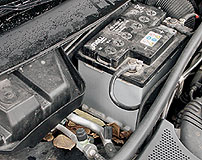 Water will find a hole.
Water will find a hole. And if it is not, the battery after rain or melting snow will swim in the bath. When it is overflowing, water can leak into the salon and pour vital electronic blocks. Each of them costs at least $ 400. To prevent this from happening, in the spring and autumn the drainage holes should be cleaned next to the battery and the salon filter. They tend to clog with foliage and dirt.
They are so different
In terms of gasoline engines, the passat is a typical German car. In the sense that a wide range of engines is offered for him and that they all differ in good oil appetite. If in high-speed modes a 4-cylinder engine drinks up to 500 g, and V6 to 800 g per 1000 km is a normal phenomenon. Moreover, the main part of the oil burns in the cylinders. Losses through snotty gaskets, which will have to be changed over time, do not make the weather.
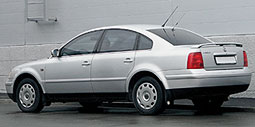 The vast majority of the passats are equipped with a 4-cylinder 20-valve engine of 1.8 liters. Without a boost, its power is 125 liters. p., with a turbine 150. According to dynamic qualities, the first version can be recognized as minimally sufficient for the Passat, and turbo rides quite seriously without any condescension. Moreover, his character is both assertive and even at the same time. It's all about a low -pressure turbine. It provides a stable, without sharp pickups, almost like that of 6-cylinder engines. And importantly, it practically does not reduce the engine resource. True, the turbine herself drank a lot of blood to the owners of the passats of 19971998. Refusages then poured from a bag. However, the turbine was brought to mind, and today its resource (approximately 150,000 km) is determined only by natural wear.
The vast majority of the passats are equipped with a 4-cylinder 20-valve engine of 1.8 liters. Without a boost, its power is 125 liters. p., with a turbine 150. According to dynamic qualities, the first version can be recognized as minimally sufficient for the Passat, and turbo rides quite seriously without any condescension. Moreover, his character is both assertive and even at the same time. It's all about a low -pressure turbine. It provides a stable, without sharp pickups, almost like that of 6-cylinder engines. And importantly, it practically does not reduce the engine resource. True, the turbine herself drank a lot of blood to the owners of the passats of 19971998. Refusages then poured from a bag. However, the turbine was brought to mind, and today its resource (approximately 150,000 km) is determined only by natural wear. Another interesting VR5 motor with a volume of 2.3 liters. Its cylinders are located in a checkerboard pattern with a very small corner of the collapse and covered with the common head of the block. On paper, VR5 has the same one as a 1.8-turbo power and almost the same dynamic indicators with it. But behaves somewhat differently. If at 1.8t with a manual box, try to move off in a small turn in the innight, he begins to strain strangle, because the turbine has not yet waned. And VR5 is already lucky with idle speed. True, it works noisy. Those who move from a 4-cylinder passat at first think that something was wrong with the motor. In the market, cars with VR5 and 1.8T are approximately the same. The five costs more only in the case of a large repair, when the engine has to be opened. But if you do not bring to that, from VR5 you will get only advantages. He does not have a turbine, and the timing is given by a chain that is incomparably more reliable than the belt. I recommend.
The maximum possible motor 193-horsepower V6 with a volume of 2.8 liters. It is also installed on Audi-A6.2,8. Can you imagine how Passat-V6 is going if this engine is enough for a heavier audi with excess? It is clear that the V6 is more expensive than other engines. Therefore, as a rule, it is found on all -wheel drive versions of synchro, which are initially expensive.
But 101-horsepower 1.6 liters are cheap. They ask for him as much as one and a half thousand less than one and eight. However, a solid and heavy passat with such a motor is more likely real estate. Especially with an automatic box.
Gasoline motors in operation
Given the addiction of the passato engines to the oil, with intensive operation of the machine, its level should be monitored weekly. But even if from that to that (it is carried out after 15,000 km) a 5-liter canister will go, do not save on the quality of the oil. The engine equipped with valve hydraulic compensators and, especially, a turbine, is better to feed synthetics.
Candles, even platinum, rarely withstand more than 30,000 km on our gasoline. Please note that to remove candle caps, a special key is required on most motors. If it is replaced by skillful hands, a set of candle wires is also replaced. The state of the timing belt must be checked on each, starting with 90,000 km, and it should be changed at a maximum of 120,000 km and be sure with the rollers. Even if the instructions indicate a large frequency.
In addition, on all gasoline engines, you can expect the failure of the coolant temperature sensor and air flow rate (throttle). With a faulty sensor, the motor starts poorly, and V6 ... stalls in corners. If the flow meter is spoiling, engine speeds can spontaneously increase, fall or hang at the same level.
1.6
Well, he does not want to work under the hood of the Passat. Even absolutely working, starts in the cold with a second or third attempt. This is not treated.
1.8 and 1.8t
By car 19971998, modeling belt tensioner of the old -style timing that causes a break of the belt can stand. Replace it immediately with a new sample part with the belt.
If, after replacing the candles, the engines continue to trumpet, check the ignition coils. In this case, they are not eternal.
Another possible disease of these motors is a roar similar to a knock of hydraulic compensators. Perhaps this is really them. But the cause of the knock may also be a valve in the oil filter bracket, an oil pump and a chain of camshafts. In order not to have to change everything at once, it is better to entrust a malfunction to the mechanics specializing in Volkswagen. They know the logical search chain.
Until 1999, the Modern Motor had problems with launching raw weather. It is treated with reprogramming of injection and, in some cases, replacing injectors. At 1.8t, when the time comes to change the turbine, it is preferably forcibly replacing its oil supply pipe. If the tube has been closed, a new turbine will not live long.
VR5
This one also often fits, so to speak about a 5-cylinder motor. In this case, the reason should be sought in candle caps. There are no other specific sores for VR5.
V6
Particularly snotty motor: gaskets of valve covers and tensioners of circuits of camshafts flow. It is advisable to combine the timing belt on it with the replacement of the water pump. It will last a little longer, and if you do everything in the complex, it will turn out significantly cheaper. We indicated the cost of replacing the belt with pomp.
What is the price
Replacing engine gasket (1.8/1.8t/v6) $ 220/220/350
Replacing candles (1.6 and 18,/18, t and VR5/V6) $ 55/105/110
Replacing the timing belt (4-cyl./V6) $ 275/530
Replacement of air flow meter $ 340-430
Protraining of injection/ replacement of nozzles $ 15/540
Replacing a turbine with a pipe $ 1550
Oil valve replacement $ 75-135
Oil pump replacement $ 390
Replacing the camshaft chain tensioner (1.8/1.8t) $ 555/310
Diesel Volkswagen Correct diesel engines
We have repeatedly said that the economic benefit of the acquisition of a diesel car, and even more used, is doubtful in our conditions. Given the large mileage of the car (to drive 20,000 km per year, they don’t buy a diesel car) and the quality of the domestic diesel fuel, the prospect of expensive motor repair is very likely. But if you fundamentally decide to buy a car with a diesel engine, but there is no money for Mercedes, the products of the Volkswagen concern should be considered first. Although not all diesel engines installed on the Passat deserve such a recommendation.
As on any foreign car, on the passat it is necessary to clean the radiators from dirt annually in order to avoid overheating of the engine. However, the radiator and tubes of the air conditioner is unlikely to protect the Moscow mud for three years in three years. The problem is aggravated by the fact that by this time threaded joints are accurately boasting and an attempt to replace a 100-dollar tube can turn into a replacement of the entire metal line. For reference, only the air conditioner radiator costs $ 510.
For a used machine, 1.9-liter turbodiesels with a capacity of 90 and 110 forces are most preferred. They are the most popular. The 110-horsepower is especially good, equipped with a turbine with variable geometry. In dynamics, it is not inferior to atmospheric gasoline one and eight, and even 1.8t is surpassed in burden. Mechanics characterize 90 and 110-horsepower engines as quite reliable, repaired and responsive to a good attitude. If they properly serve and comply with the general rules for the operation of turbodiesel, they do not cause any special problems.
In 1999, a 115-horsepower engine appeared, equipped with individual pumps instead of the usual high-pressure fuel pump (TNVD). How he will behave in operation is still unknown. Russian dealers did not sell such cars, and they moved to the category of three -year -olds recently.
In terms of characteristics, a 150-horsepower 2.5-liter V6 simply looks great: dynamic, quiet, completely unable to load. That one person is in a car, that five and a heavy trailer on his tail do not care. However, the 6-cylinder diesel diesel in operation proved to be capricious and extremely demanding on the quality of service. Not only is it originally as a gasoline V6 (even in the secondary market), it can also drive into large expenses.
Caring with diesel engines
Given the quality of our fuel, it is advisable to make the following adjustments to the owner of the diesel passat in the frequency and volume of service. The oil and all filters, without exception, are changed after 10,000 km, and the timing belt after 60,000 km on 90- and 115-horsepower engines and after 90,000 km on 110-horsepower and V6. In addition, it is necessary to rinse the fuel tank annually and clean the injection cabins on a special installation. The latter, by the way, are distinguished by enviable durability. Even in our diesel fuel, they nurse 150,000200,000 km. About the same amount of proper operation can also last a turbine. So that she does not give up the spirit before, it is necessary to monitor the level of the oil and do not flood the engine immediately after stopping, letting it work with half a minute at idle.
In order to avoid major troubles, on 90- and 110th engines it is advisable to immediately change not only the timing belt with rollers, but also the gear of the crankshaft and its bolt, which is prescribed to do with each second replacement of the belt. Moreover, the bolt is installed using special technology. If it is not observed, the timing gear may be described and then the destruction of the engine
In addition, on engines with a capacity of 90 and 110 forces, over time, you will probably have to change the tensioner of the auxiliary unit drive belt (serves about 100,000 km) and air flow meter. The glued tensioner begins to rumble, and the dying flowmeter manifests itself in failures and power loss. But the fuel pump, which is at risk at any diesel engine, is quite successfully repaired.
On a 6-cylinder engine, simultaneously with the timing belt, it is necessary to forcibly change the belt of the auxiliary unit drive and all five of its videos. The fact is that the jumping or broken drive belt on this motor is tightened under the timing belt. The result is the same large engine repair. The next moment is the engine fan check for the backlash. If there is one, it is necessary to change the fan of the fan along with the bearing. Otherwise, the painted fan can reach the radiator.
Owners of V6 should stay away from dubious gas stations and are serviced only in the corporate Volkswagen service or a specialized diesel center. TNVD on this engine is quite expensive and is not repaired. And it fails even after an unskilled replacement of the fuel filter or an inept attempt to merge from it.
What is the price
Replacing turbine $ 1100-1350
Replacement of nozzles (4-cyl./V6) $ 580/830
Repair of HTNVD (4-cyl.) $ 500-800
Replacement of the pumping unit (V6) $ 1950
Replacement of the viscous factor of the fan (V6) $ 290
Replacing a timing belt with a gear and a bolt (4-cyl.) $ 300
Replacing the timing belt and drive belt (V6) $ 650
Mechanics or machine gun?
The number of proposals for used passats is such that it is possible to purposefully choose not only the engine, but also the gearbox. There are no restrictions here. With any of the engines, both manual and automatic transmission are combined.
After the design of the problematic main clutch cylinder changed in 1998, the manual box with a lifelong supply of oil does not cause complaints. With age, only the sealing oil seal can flow with age. But replace his business. But the original clutch kit, which serves an average of 120,000150,000 km, is just right for $ 500,600 to sell air parts in stores. It is better to buy a kit of a company onions or ZAKS. It will cost almost half the cheaper.
Synchro \u003d croatro
What, at first glance, are different cars of the Volkswagen-Passat and Audi-A4 of the previous generation. In fact, constructively this is the same car. It is not surprising that both have many common units, including the all -wheel drive system. The only difference is that in the Volkswagen, unlike the audi, the four -wheel drive is traditionally called not Quattro, but synchro.
On the Passat, a transmission of Audi with a constant drive of all wheels and an interax differential torsen was used. Initially, he shares the torque between the front and rear wheels equally, but can distribute it in the ratio from 25:75 to 75:25. Such a scheme provides predictable behavior on a slippery road and good cross -country ability.
Passat Sinchro can be equipped with a manual or automatic box and any of the engines, with the exception of 1.6 liters and a 90-horsepower diesel. But most often synchro is found in the market with V6 engines. If funds allow, you can buy an all -wheel drive machine without fear. Problems with a cardan shaft can occur only if it is incorrectly installed (for example, after replacing the clutch).
In the handout and gearbox of the rear axle, the oil is flooded for the entire service life. Mechanics will only remain to control its level, as well as the condition of several additional seals and rear drive covers. Even if over time you have to change some elastic bands is inexpensive.
In reality, the all -wheel drive passat has only one small problem of short -lived fuel level sensors. In the event of a malfunction, all three ($ 300) must be changed. The design of the sensors was changed several times. The last option, entering spare parts, seems to be successful.
The reliability of the automatic box on the Passat depends, including on its design. With gasoline engines with a volume of 1.6 and 1.8 liters without turbocharges, as well as with a 90-horsepower diesel, an old 4-speed automatic is combined. Its age is manifested in tangible delay during switching and in the need to change oil after 60,000 km. But it is quite reliable and durable up to 200,000 km can only be broken intentionally.
With all more powerful engines, a modern 5-speed tiptron with manual switching mode is aggregated. It works much softer and clearer, and the oil is not provided in it. However, problems with the Testronics begin already by 150,000 km.
Do not drill the tiptron through and through
If you want to install an anti -theft lock of the gearbox on a machine equipped with a tiptron, remember the following. By making a hole under the pin of the lock, you can damage the electronic board responsible for manual switching mode. After that, the box will cease to be a tiptron, turning into an ordinary 5-speed machine.
In addition, on the production machines until 1999 of the model year, road salt can kill an electric connector included in the electronic control circuit of the automatic machine. At the same time, the box rises in the emergency mode, as evidenced by the sunbathing automatic transmission malfunction. It is treated by repairing the connector and removing the malfunction code from the computer.
What is the price
Replacing electronic board $ 240
It would seem that the life of the machine can be extended by a change in oil, which is done by many owners immediately after buying a used car. But experienced mechanics specializing in Volkswagen and Audi try not to undertake this operation. Because on cars with a high mileage, Testronics can die immediately after changing the oil. That is, you have a choice: either do not touch the box (more precisely, only control and, if necessary, add oil), passively awaiting it of natural death, or try to try in the lottery. Tipronics repair in a specialized automatic workshop costs $ 17002400.
Do not arrange a swamp in the cabin
If the machine began to be put on the alarm after a signaling, spontaneously locks up, the central lock is spilled or, upon arrival at the parking lot, The block is located near the driver’s left leg, behind the upholstery and suffers from water and salt brought in the cabin on the legs. Therefore, the Koretz mats on the floor and cleanliness in the passage salon are mandatory conditions.
However, door locks and glass windows can also be splendered with a working comfort unit. If the castle electric lock flew, you will have to change the lock assembly. In the windows, an electric motor with built -in electronic brains, or a mechanism, fails. In both cases, glass along the way comes to the middle and spontaneously drops down.
The trapezoid of the wiper also suffers from salt. In Moscow, she is enough for three years. Lubrication helps for a short time. It is better to replace the trapezoid.
Two more candidates for departure Central Switch Switch and an alarm button. If the overall lights or headlights do not turn on, go out from shaking on irregularities or light up one side, which means that you can not spend money on searching for a malfunction. Change the central switch. The same is with the emergency gear, if the button is jammed or the turns indicators are sticking in a burning state.
All problems with electricity are age -related. The owner of a new car in the first three years is usually not encountered.
What is the price
Replacement of the electric engine of the windshield $ 275
Replacement of the glass windows mechanism $ 155
Repair of the glass cleaner trapezoid $ 135
Replacing the central light switch $ 100
Replacing the alarm button $ 30
Oh, these levers
The survivability and cost of the details of the multi -leaf front suspension of the passata became the parables in the tongue. However, a similar suspension with similar problems was applied on Audi A4, A6 and A8 models. It’s just that the Passat was the first mass car of the Volkswagen concern in Russia with an aluminum multi -link. At first, the suspension began to show signs of fatigue after 20,000 km and completely understood 50,00060,000 km. Therefore, the owners of used cars are accustomed to the fact that on each one has to change at least a couple of levers.
Since then, the Germans have repeatedly changed the design of the levers, trying to increase their service life. As can be seen from the table, the details of the new sample became somewhat stronger, although also not ah. Especially considering that a set of branded levers costs $ 1300, however, you can use high -quality non -original (for example, Lemferder or Phoebee). Such levers will serve slightly less, but they cost $ 600700 per set.
In addition, in the 1999 model year, the design of the stabilizer racks and tips of steering rods, which were enough for a maximum of 20,000 km, were changed. If your car still stands old -style details, replace them with new ones. First of all, check the tips. The old aluminum (now they are steel) on the bumps simply opened, and the wheels scattered in different directions.
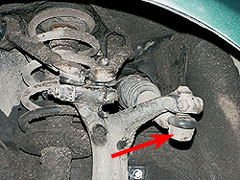
On the production machines until 1999 of the model year, pay attention to the tips of steering rods (shown by an arrow). If they are aluminum, urgently change to steel
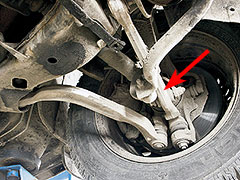
The weakest levers of the front suspension are the lower straight lines (shown by the arrow)
There is nothing to blame the remaining details of the chassis. For example, shock absorbers sample of reliability. The rear suspension of monoprodic vehicles is generally trouble -free. Even in the all -wheel drive version of the synchro, as you see, it does not really burden the owner. Everything is in order with the brakes: ABS sensors are reliable, and sometimes the calipers shallow from dirt almost always manage to develop. Of the unscheduled expenses, only the replacement of the hoses of the power steering and the rear brake hoses, which may begin to get wet after 100,000 km. But this is not the money that is worth talking about.
Buy?
As you were convinced, the Passat with age becomes quite moody and expensive in operation. Even if you use non -original spare parts and services of an unauthorized service, its content will still be burdensome. However, a similar situation with reliability and operational costs is typical for modern German cars. And in the aggregate of consumer qualities, whatever one may say, the Passat still remains the best in the class. Are you ready to pay for possessing the best car? If ready, you can start choosing.
Before you go to the market, remember that the Passat is really very popular (chi-tie mass) car throughout Europe. And in the nomination, the service car is generally an unconditional leader. When in the secondary market the proposal is so great and the demand is just as great, the buyer will be found for any product. In such a situation, it is enough to feel true for a thousand dollars to get a car driven to a half -target or hazel -free -hazel -free car. If you want to buy a three -year -old brought from Europe in good condition, not very broken, qualitatively repaired, with real mileage up to 120,000 km, the seller should not retreat from more than $ 500 from the prices below.
1.6 $ 13,00014,000
1.8 and 1.9 tdi
(90 l. P.) $ 14 50015 500
1.8 T, VR5 and 1.9 TDI
(110 l. P.) $ 15,00016,000
V6 2.5 TDI $ 18,00019,000
V6 2.8-SINHRO $ 19,50021,000
Here, the cost of cars is given in the average configuration for the Passat: manual or automatic box, climate control, electric package, velor salon, factory music and some other little things. If the car is stuffed to the eyeballs, including a leather interior with a wooden trim and an electric drive or, conversely, there will not even be an air conditioner (this is also possible), the price in one or another side should not differ by more than a thousand.
The battery was discharged call the tow truck
Try not to leave the Passat in the parking lot with electric consumers (including under the alarm) for a long time. If the battery sat down when the doors were locked (usually it happens), it will not be possible to open them even with a key. It remains to call a tow truck and carry the car to the corporate service.
The terminal from the battery should not be removed without need. After that, the engine begins to work according to the bypass program, without developing full power. To bring it to life on the service, it will be necessary to introduce basic adjustments into the computer.
Alexander Konov, photo Alexander Sadovnikov
Source: Magazine "Limousine" [01-02/03]
Video Test Drive Volkswagen Passat B5 2000 - 2005
VOLKSWAGEN Passat B5 2000 - 2005 - 2005
Volkswagen Passat B5 2000 test drives - 2005
Krash Test Volkswagen Passat B5 2000 - 2005
Krassh Test: Detailed Information28%
Driver and passengers
13%
Pedestrians
Malfunctions Volkswagen Passat B5 2000 - 2005
Volkswagen Passat malfunctions: Detailed information| Passat B5 2000 - 2005 | |
|---|---|
| Engine |  |
| Transmission |  |
| Control system and suspension |  |
| Brake system |  |
| Air heating and air conditioning |  |
| Launch and charging system |  |
| Electric components and so on |  |
| Corrosion body stability |  |








